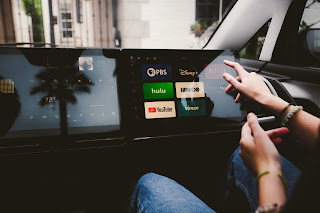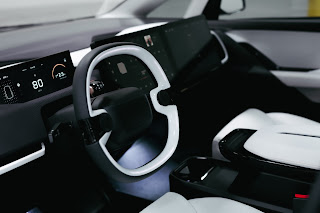What attracted you to this project and to join a start up?
Starting something from scratch and leading a team
towards a common vision was the challenge and the appeal. Little did I know I would actually learn in the process about building cars and
managing people, would be so much more valuable.
How did the company come up with the name and logo of the vehicle?
Our founder wanted from the beginning for IndiEV to be
a place for independent minded people that wanted to try and create something
new. Independent, hence IndiEV.
Our iconic logo is an abstraction from the computer chip or circuit board found in today’s computing array’s. At first glance, you can see that. At another glance, you will notice it says ‘INDI’ within. It feels technical, modern and relevant.
What was your role in bringing this prototype to the market?
I have headed the design and development of the Indi One, as well as the development of our brand essence and look. Essentially, I’ve
guided a small group of creatives towards a cohesive message. Being a
start-up, you must wear many hats (I have found this to be no exaggeration). I was also responsible to guide our engineering team to the execution of that
message. Sometimes I’d be sketching or modelling with the designers. Sometimes
I’d be working on contract negotiations. And other days, I’d be sanding parts in
the prototype shop. Never, ever bored!
How many designers worked under your guidance to create this masterpiece?
Our design team has been anywhere from six to twelve, at any given time.
Since your days at Hyundai, many of your projects involved collaborations with designers from around the globe. Was the design team for this project based in the U. S.?
Most of my team has been based here in Southern
California. But there have been times, that some of our resources were based
overseas. Remote working showed us that we could progress a program. With great guidance and communication, it was actually
nice to work on things around the clock.
Why did you opt for a futuristic design, as opposed to a more traditional design?
At the core, our Indi One is about the open-source computer. Its the heartbeat of the vehicle! Throughout this entire process, we really looked at this product as being more of a digital tool that is mobile than a traditional car. With that premise, the design was driven to a cleaner, less organic aesthetic. Every detail of the Indi One feels more as though it was derived from a digital component and not a piece of clay.
Whom or what inspired the design? And what impact if any did gaming have on this vehicle?
As mentioned in my previous answer, with so much of the market going towards more organic design, (which ironically, we championed at Hyundai over a decade ago). We wanted to stay cleaner and more product-like. Gaming is a part of our story and there is some reference to that. When you look at the steering wheel for instance, it feels like a game controller with key interfaces under your thumbs and a strong overall graphic feel. Also, we’ve brought the driver-assist warnings visually into the steering wheel face, giving a slight 'gamification' of those features.
Since gaming isn't a lane the auto industry has focused on, why was it a focal point of this vehicle?
Gaming is certainly a part of our story, but not the whole story. The powerful open-source Window’s based computer, which is at the heart of our vehicle, will enable us to take in-vehicle level gaming to the next phase.
With the integration of the latest augmented reality (AR) and virtual reality (VR) capabilities and use of the vehicle’s onboard camera systems, the time spent in the car can and will certainly be used differently. That system will enable elevated levels of social connection and work productively as well.
Will gaming be the theme for future vehicles from this brand?
Not so much gaming, but the possibilities of having a mobile computing platform. In the coming months, you’ll see how we believe this can expand to various aspects of life and other product offerings.
Will self-driving aids be included with this new midsize model? With this vehicle having a supercomputer, consumers would expect such. If no, why not?
Our first product will have a
high-level of driver assist features ... but it will not be autonomous. We will expand
on our capabilities on the foundation, but it was important for us to create an
entry into the market that offered the digital capabilities at the prices point
we are targeting. There is still much work to be done to make this a "true autonomous' vehicle. And I
think that there has been some misleading information shared from others in the industry on that subject.
Besides the gaming, what separates this EV from others on the market?
Imagine everything that your home PC is capable of. Some people use their home computers for business productivity; some use them for creative applications: social content creation, video gaming, music creation, crypto mining… the list goes on and on.
Now combine that with various hardware additions: like cameras, microphones, AR, VR in an object that moves with you on outings, roundtrips and daily migrations. That is what the Indi One is all about.
It’s hard as a new player to the market. If you come into the market at too premium of a price point (into the six figures), you certainly create a ‘halo’ vehicle... but you eliminate so much of the potential buyers. If you come into the marker too low, its really difficult to move up market with product offerings. This has been historically proven with many “affordable” brands eventually coming up with a new brand nameplate altogether just to move a more premium offering. We think this midsize and mid-price point is a wise placement for our first vehicle. It gives us room to move both up-market and down-market and most importantly keep the Indi One relatively attainable.
To read part two of our conversation with design director Andre Hudson, click here.





.jpg)



No comments:
Post a Comment